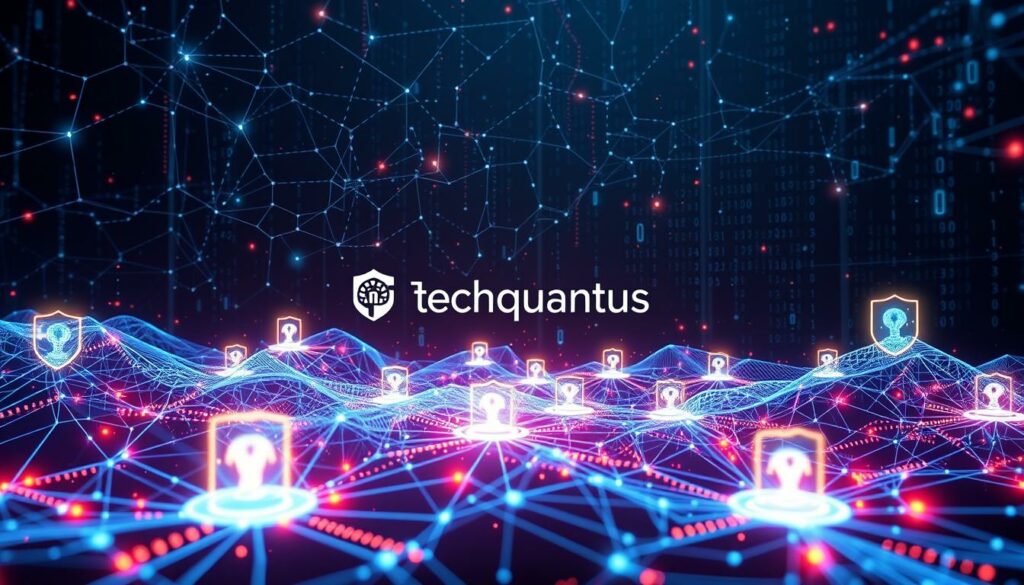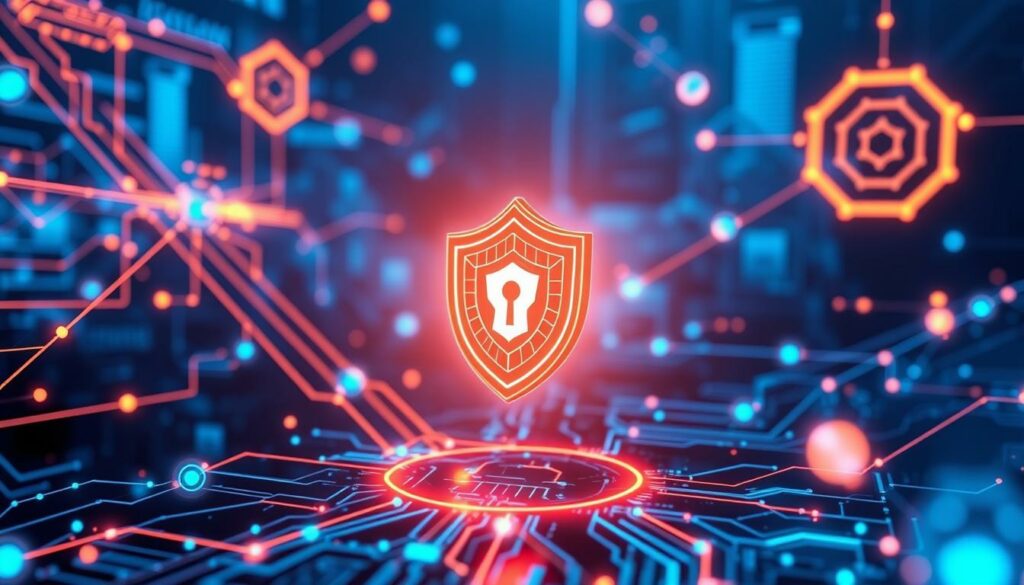Did you know that 73.1% of AI experts see data privacy and security as big challenges for businesses using big language models? This fact shows how important it is for companies to update their cybersecurity plans. In today’s world, making your cybersecurity strategy better is crucial. With cyber threats getting more complex, using AI in cybersecurity is key to keeping digital assets safe.
When you’re dealing with complex security issues, adding AI to your cybersecurity can really help. This article will show you how to make your cybersecurity strategy better. You’ll get tips that help you protect important assets and keep your operations running smoothly.
Key Takeaways
- AI-Driven Cybersecurity is essential for organizations facing modern cyber threats.
- Implementing AI can significantly reduce data exposure incidents and enhance data lifecycle visibility.
- Real-time data processing is crucial for effective threat detection and response.
- Using tools like HackerGPT can streamline your cybersecurity operations.
- Ethical considerations should guide your approach to utilizing AI in security measures.
The Importance of Cybersecurity in Today’s Digital Landscape
Cybersecurity is crucial in today’s digital world. As we connect more, we face more risks. This means companies must be on high alert for cyber threats.
Reports show a big jump in cyberattacks lately. To stay safe, businesses need to act fast. They must protect data, keep customers’ trust, and follow the law.
Many companies are now using cybersecurity insurance. This shows they understand the big risks of data breaches. With AI, these policies can fit a company’s specific needs, making them more effective.
AI tools are getting better at spotting risks. They look at lots of data, like how people use the network. This makes finding weak spots more accurate.
The use of AI also cuts down on fake insurance claims. This makes things faster and more reliable for companies. It also builds trust in how claims are handled.
| Statistic | Percentage |
|---|---|
| Increase in Cyberattacks | Significant |
| Companies Adopting Cybersecurity Insurance | Notable Increase |
| Businesses Tailoring Cyber Insurance Policies | Higher Level of Customization |
| Time Reduction in Claims Processing | Substantial Reduction |
| Reduction in Fraudulent Claims | Notable Decrease |
| Accuracy Improvement in Risk Assessment | Significant Improvement |
The digital world is always changing, making strong cybersecurity a must. Good cybersecurity helps protect companies and keeps them running well, even with threats around. Using new tech like AI helps tackle current and future cybersecurity challenges.
Understanding AI-Driven Cybersecurity
AI-Driven Cybersecurity uses AI to fight cyber threats. It’s a big step forward, where AI looks at lots of data to spot suspicious patterns. This helps companies protect their digital stuff in a new way.
What is AI-Driven Cybersecurity?
AI-Driven Cybersecurity means using artificial intelligence to watch over, find, and stop threats right away. This makes things run smoother, helping companies tackle weaknesses better. With more cyberattacks happening, AI helps fight back early and quickly.
Key Benefits of Integrating AI in Security Strategies
Using AI in security has big advantages. Companies that add AI to their security often see:
- Enhanced Threat Detection: AI spots oddities way faster than old methods.
- Improved Incident Response: Automation means quicker action, less damage.
- Greater Operational Efficiency: AI does boring tasks, so people can focus on big ideas.
- Advanced Security Strategies: AI lets for smarter ways to tackle new threats.
With more digital stuff everywhere, like in banking and online shopping, AI is key. The market shows this, especially in places like Germany, where AI in security was worth USD 1.08 billion in 2023 and is growing fast. Companies must see how vital AI is for strong security. For more on the growing threat of ransomware, check out this link.
Leveraging AI for Threat Detection
The digital world is always changing, making it key to use artificial intelligence for threat detection. AI systems use complex algorithms to look through lots of data from networks and devices. They learn from new data to spot normal and suspicious actions fast. This helps protect your organization by acting on threats early.
How AI Threat Detection Works
AI threat detection uses advanced data analysis with machine learning. It combines deep learning and behavioral analytics to check data in real-time. This helps spot signs of fraud, important for banking and e-commerce. AI can go through a lot of data, giving better protection against new threats.
Examples of AI Threat Detection Tools
Many AI security tools are leading the way. Tools like Darktrace and CrowdStrike use AI to improve threat detection. Here’s a table that shows some top AI threat detection tools, their features, and where they’re used:
| Tool Name | Features | Applications |
|---|---|---|
| Darktrace | Autonomous response, anomaly detection algorithms | Enterprise cybersecurity, network monitoring |
| CrowdStrike | Real-time incident response, behavioral analytics | Endpoint protection, threat intelligence |
| Palo Alto Networks | Integrated AI capabilities, automated threat detection | Network security, cloud security |
| IBM Security | AI-driven insights, comprehensive data analysis | Fraud detection, compliance |
These AI threat detection tools automate responses to threats, reducing damage. The growth of digital transformation in industries makes advanced AI crucial against complex cyber threats. A study found AI systems are better at catching new ransomware, even with tricky encryption methods. You can learn more about the latest threats by visiting the top cybersecurity threats in 2024.
Enhancing Incident Response with Machine Learning
In today’s fast-changing cybersecurity world, machine learning is key to better incident response. It looks at past incidents to learn and improve how it handles new threats. This helps your team make smarter decisions during security issues.
Machine Learning in Security: An Overview
The benefits of machine learning in cybersecurity are clear. It uses big data to spot unusual patterns and predict security risks. With AI, organizations can tackle risks early, making incident response better. This means security teams can focus on the most urgent threats and be ready for anything.
Improving Response Times with AI Systems
AI systems make response times in cybersecurity faster. They quickly sort through threats, letting your team act fast. Machine learning helps streamline processes, making things run smoother. This means your response is quick and effective, giving attackers less time to act.

It’s important to blend security with making things easy to use. Training your team well helps them make the right choices. Look into ways to manage human behavior to boost your cybersecurity even more. Check out these strategies and best practices for better awareness.
| Incident Response Strategy | Traditional Method | Machine Learning Enhanced |
|---|---|---|
| Threat Detection | Manual analysis of alerts | Automated anomaly detection |
| Response Time | Slower due to manual processes | Faster with prioritized alerting |
| Accuracy | Poor due to human error | Improved with machine learning insights |
| Training | Annual training sessions | Ongoing scenario-based training |
Utilizing Digital Twins for Cybersecurity Protection
Digital Twins are changing the game in cybersecurity. They let companies make exact copies of their digital stuff. This means they can test and improve their security without risking the real thing. By using Digital Twins, teams can spot and fix security holes right away.
What are Digital Twins?
Digital Twins are like digital copies of real systems. They mirror the real world but let you test and check things without affecting the real thing. With advanced sensors, they help find objects in 3D, making security better through smart simulations.
Applications in Cybersecurity for Real-Time Monitoring
Digital Twins are super useful for keeping an eye on things in real-time. They help test and find security weak spots. They act as early alarms, catching problems before they turn into big breaches. Plus, they’re key in testing cybersecurity, making sure security plans and patches work well.
| Feature | Benefit |
|---|---|
| Real-time Data Processing | Enables immediate response to security threats |
| Vulnerability Prediction | Identifies weaknesses before they can be exploited |
| Enhanced Testing Scenarios | Improves the accuracy of cybersecurity simulations |
| Adaptive Learning | Changes security based on simulated threats |
Using AEPF for 3D object detection makes cybersecurity better. Digital Twins offer new ways to improve security. They help companies make their cybersecurity stronger.
Integrating Cybersecurity AI Tools into Your Strategy
In today’s fast-paced digital world, picking the right AI solutions is key. With so many cybersecurity technologies out there, it’s hard to know what to choose. You need to think about what your organization faces, like how big it is, how well it fits with other systems, and how easy it is to use.
Talking to vendors and seeing demos can help you find the best tools for your setup. This way, you can make sure they work well with what you already have.
Evaluating the Right AI Solutions for Your Business
When looking at cybersecurity tech, make sure it matches your company’s goals and how it works. Using machine learning can make things run smoother and improve how you analyze data. It’s important to have a strong data architecture for machine learning to work well.
This means making sure data moves smoothly in your apps. Also, cleaning your training data and picking the right features is key to making your models more accurate.
Considerations for Implementation
Putting AI tools to work takes careful planning and the right resources. It’s important to test them well before you start using them for real. Keeping an eye on how they perform helps keep your cybersecurity strong against new threats.
It’s also key to keep your machine learning models up to date. This keeps them accurate. Investing in data-driven strategies can give you an edge by automating key parts of your data projects. For more tips on improving data applications, check out this resource.

Challenges and Risks of AI in Cybersecurity
AI in cybersecurity brings new challenges and risks that companies must handle with care. As AI gets better, it might have new problems like biases in algorithms. These biases can lead to wrong positives or negatives, making it harder to spot threats. This means hackers can use machine learning and genAI for more complex attacks. So, it’s crucial to have strong cybersecurity risk management.
Potential Risks Associated with AI Use
AI has ethical concerns that need attention and action. Using AI can make cybersecurity weaknesses worse, letting hackers find new ways to break through defenses. The risks of AI in cybersecurity include:
- Algorithmic bias: Bad data can cause AI to make wrong decisions.
- Attack sophistication: Hackers might use AI to outsmart traditional defenses.
- Transparency issues: AI’s lack of clear explanations can make it hard to trust and follow rules.
- Human reliance: Relying too much on AI can reduce the need for human skills and oversight.
Strategies for Mitigating Risks in AI-Driven Approaches
To deal with AI risks in cybersecurity, companies should use strong strategies. Following best practices for AI security can improve cybersecurity plans. Important strategies are:
- Using robust governance frameworks to manage AI responsibly.
- Doing regular checks to make sure AI works well and ethically.
- Using multi-faceted security practices, like encryption and access controls.
- Providing ongoing training for staff to keep up with new challenges.
- Keeping up with updates to the Cybersecurity Framework, especially NIST’s Version 2.0.
The HIMSS Healthcare Cybersecurity Forum will highlight how important transparency and explainability in AI are. Clear communication about what AI can and can’t do is key to building trust and managing risks. Companies need to stay alert and adjust their plans to meet new cyber threats.
| Risk Factor | Description | Mitigation Strategy |
|---|---|---|
| Algorithmic Bias | Inaccurate outputs due to skewed data | Implement diverse training datasets |
| Advanced Exploits | Increased sophistication in cyber-attacks | Continuous threat intelligence monitoring |
| Lack of Transparency | Difficulty in understanding AI decisions | Enhance explainability in AI systems |
| Human Oversight | Reduced human involvement in security decisions | Training programs to maintain analytic skills |
Case Studies of Successful AI Implementation in Cybersecurity
Many organizations have seen big wins with AI in their cybersecurity efforts. Banks are a prime example, using AI to spot fraud in real-time. This has greatly reduced fraud cases. These AI success stories show how tech helps protect financial data.
In the tech world, machine learning has boosted how well malware is detected. Companies use these algorithms to catch threats early. These case studies in cybersecurity show better detection and stronger defense against cyber threats.
The healthcare field is also seeing big changes, thanks to AI. AI systems watch for data breaches and act fast. This keeps risks low and builds trust in digital health services. A survey found that 96% of healthcare leaders think AI gives them an edge. This proves the value of using AI wisely in cybersecurity.
Innovation and Future Trends in AI-Driven Cybersecurity
The future of AI in cybersecurity is changing fast. As cyber threats grow, new security strategies are key to protect digital assets. In 2023, the German AI in Cybersecurity market hit USD 1.08 billion. This shows how important AI is in fighting complex cyber issues.
The market is expected to grow by 21.08% each year. This growth means companies must use new cybersecurity methods. They need to use advanced tech to get better at defending against threats. Cyber threats are getting harder, so adding AI to security plans is crucial to stay safe.
New trends like automated threat hunting and behavioral biometrics are emerging. These help find and stop threats before they happen. Working together, humans and AI will make cybersecurity better in the future.
AI is becoming a big part of cybersecurity in Germany, thanks to new laws and more digital use. Companies are now getting most of the top AI PhD graduates. This talent helps train AI models fast and create strong cybersecurity solutions.
| Trend | Description | Impact |
|---|---|---|
| Automated Threat Hunting | Uses AI to find threats on its own | Speeds up how fast we can respond to threats |
| Behavioral Biometrics | Checks how users behave to spot odd actions | Makes verifying users safer and cuts down on fraud |
| Collaboration between Humans and AI | People and AI work together to fight threats | Makes responding to threats more efficient and effective |
| Regulatory Compliance | Following stricter security rules | Pushes for updating security measures |
In the future, AI will not just secure systems but also shape how we protect them. As cybersecurity changes, so will the tools and strategies we use to fight threats. For more info on the growing market and its trends, see this report on Germany’s AI in Cybersecurity.
Conclusion
AI-Driven Cybersecurity strategies change how we protect our digital assets. They use advanced machine learning and new technologies to make our defenses stronger. This helps us respond faster to threats.
It’s important to understand these technologies to follow the best cybersecurity practices. When making a plan, think about getting strong solutions for now and the future. This way, you’re ready for any cyber risk that comes your way.
Building a secure digital world is hard, but staying up-to-date with cybersecurity is key. By focusing on these strategies, you can keep your data safe and secure.
FAQ
What is AI-Driven Cybersecurity?
AI-Driven Cybersecurity uses artificial intelligence and machine learning to fight cyber threats. These technologies look at big data to spot suspicious patterns. This helps make organizations more secure.
How do AI threat detection tools improve security?
AI threat detection tools look at data from networks and devices. They learn from new data to spot threats early. This helps stop attacks before they get worse.
What are the key benefits of integrating AI into cybersecurity strategies?
Integrating AI boosts threat detection and speeds up response times. AI can process data faster than humans. It automates routine tasks and helps use resources better.
What role does machine learning play in cybersecurity?
Machine learning is key in cybersecurity. It analyzes past incidents to predict vulnerabilities. This helps improve security decisions during incidents.
How can Digital Twins be used in cybersecurity?
Digital Twins create virtual copies of systems. This lets organizations test and analyze system performance in real-time. They help spot security weaknesses and test for vulnerabilities.
What should organizations consider when selecting AI cybersecurity tools?
When choosing AI cybersecurity tools, look at scalability, integration, ease of use, and fit with your setup. Trying out demos with vendors can help pick the right tools for your needs.
What are the challenges and risks associated with AI in cybersecurity?
AI can have biases leading to wrong detections, and hackers might use AI too. It’s important for organizations to stay alert and adapt when using AI in security.
How can organizations mitigate AI-related risks?
Use strong governance, check AI systems often, and follow security steps like encryption and access controls. Training users and keeping them informed helps protect against threats.
What are some successful case studies of AI implementation in cybersecurity?
Many companies, especially in finance and tech, have used AI for spotting fraud and malware. This has made their security better, shown by fewer incidents.
What future trends should organizations watch for in AI-driven cybersecurity?
Watch for automated threat hunting, behavioral biometrics, and AI and human teaming. New AI tech will help fight complex cyber threats better.
Source Links
- https://www.cybersecurity-insiders.com/addressing-critical-challenges-in-responsible-enterprise-ai-adoption/
- https://www.rtinsights.com/why-real-time-businesses-need-flight-data-recorders/
- https://www.hackersking.in/2024/09/hackergpt-ai-powered-cybersecurity-tool.html
- https://timestech.in/employee-benefits-and-cybersecurity-insurance-how-ai-is-transforming-risk-assessment-and-coverage/
- https://www.csoonline.com/article/3498551/whats-next-after-the-ciso-role.html
- My Guide to Understanding Data Centre Architecture: Core Components Every IT Pro Should Know
- Wazuh Home Network Setup: A Step-by-Step Guide
- Quantum Computers Decrypting Blockchain: The Risks and Implications
- Wazuh: Enterprise-Grade Security for Your Business
- Wazuh for Beginners: A Comprehensive Guide
Related posts:
 How AI is Revolutionizing the E-commerce Industry
How AI is Revolutionizing the E-commerce Industry
 The Role of Quantum Computing in Drug Discovery
The Role of Quantum Computing in Drug Discovery
 How to Ensure Data Privacy Compliance in 2024
How to Ensure Data Privacy Compliance in 2024
 How to Leverage Hyperautomation for Streamlining Operations
How to Leverage Hyperautomation for Streamlining Operations
 How to Implement Robotics for Business Process Automation
How to Implement Robotics for Business Process Automation
 Why Next-Generation Firewalls Are Critical for Modern Enterprises
Why Next-Generation Firewalls Are Critical for Modern Enterprises
